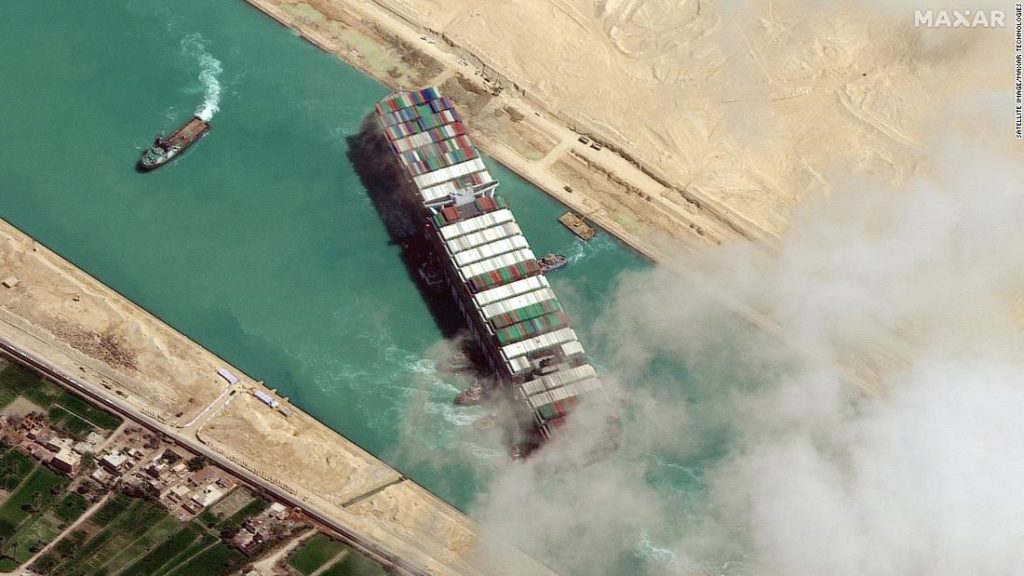The 30-kilometer-long area will be widened by 40 meters (131 feet) to the east and deepened to 72 feet, up from 66 feet, according to the SCA. Plans also include extending the second lane near the Great Bitter Lake, which opened in 2015, by 10 kilometers (6 miles) — allowing two-way traffic along an 82 kilometer (51 mile) stretch.
The work is intended for “maximizing the canal’s efficiency and shortening the vessels’ transit time, as well as raising the navigation safety,” said a press release from the SCA. But there are still questions as to whether this will be enough to prevent future blockages.
“The widening of the canal is a smart move,” Sal Mercogliano, a maritime historian at Campbell University in North Carolina, tells CNN. “The question that I have is if you widen the canal, then will vessel operators make their vessels bigger?”
Ship size
The largest ships can carry up to 24,000 containers and measure over 200 feet at their widest point — wider than a standard American football field. The Ever Given — which can hold up to 20,000 containers but was only carrying 18,000 at the time of grounding — is in the top 1% globally in terms of vessel size, measuring 400 meters (1,312 feet) long and 59 meters (194 feet) wide.
Shipping companies argue that bigger ships are more efficient at carrying large volumes of cargo across the globe and — in normal conditions — they are able to pass through the Suez.
But “it’s a very narrow margin of error,” says Mercogliano. If there are strong winds — as in the case of the Ever Given — or bad visibility, ultra-large vessels risk getting stuck.
The extension proposed by the SCA will help reduce the risk of ships getting stuck, but it will not erase it, says Ioannis Theotokas, a professor in the Department of Maritime Studies at the University of Piraeus, Greece.
“It will never be enough unless a second lane is opened in the southern part,” he tells CNN. But he believes that container ships are unlikely to get any bigger, so further widenings may not be necessary.
“Increasing the size of ships caused extensive investments in ports to support them. A further increase would require further investments,” which are not readily available, he adds.
“Increasing the stretch with double lane will enable more vessels to transit a vital canal that receives about 10% of the world trade flows. The deepening and widening will reduce the risk of groundings,” says Aslak Ross, head of HSE & Marine Standards at A.P. Moller-Maersk.
He adds that “the current vessel size matches our network demand and (the company) has no plans for transiting larger vessels than what we do today through Suez Canal.”
Future routes
However, the Ever Given incident did prompt discussion of alternative routes. The canal’s strategic position — connecting the Mediterranean to the Red Sea and offering the shortest sea route between Europe and Asia — is key to its influence.
“It’s no coincidence that soon after the Ever Given incident, Russia made comments of the attractiveness of alternative routes, namely the Northern Sea Route,” says Theotokas. That route runs along the Arctic coast of Russia, from the Kara Sea to the Bering Strait.
Theotokas believes the position of the Suez as a world trade route will remain strong.
“Shipping companies are always prepared to handle risk such as Ever Given,” he says. The SCA’s extension will just make them more comfortable in doing so.
“The widening of the canal will make it easier for salvage operations … even if it does not erase the risk of repeating the incident,” he says.
This story has been updated with comment from A.P. Moller-Maersk.
You may also like
-
Afghanistan: Civilian casualties hit record high amid US withdrawal, UN says
-
How Taiwan is trying to defend against a cyber ‘World War III’
-
Pandemic travel news this week: Quarantine escapes and airplane disguises
-
Why would anyone trust Brexit Britain again?
-
Black fungus: A second crisis is killing survivors of India’s worst Covid wave

